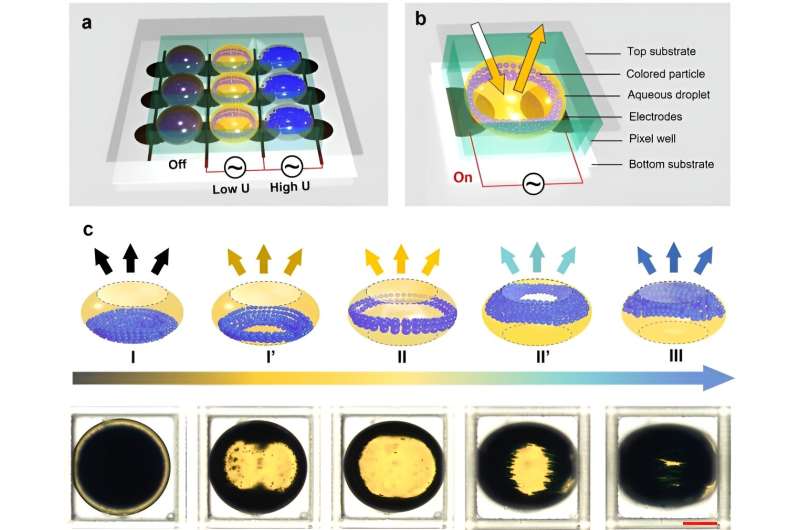This article has been reviewed according to Science X's editorial process and policies. Editors have highlighted the following attributes while ensuring the content's credibility:
fact-checked
peer-reviewed publication
trusted source
proofread
Researchers develop a reflective display technique based on electro-microfluidic assembly of particles

In an article published in Light: Science & Applications, a team of scientists, led by Professor Lingling Shui from the International Joint Laboratory of Optofluidic Technology and System (LOTS) at South China Normal University have developed an interesting reflective display technique based on an electro-microfluidic assembly of particles (eMAP) strategy, offering the advantages of easy fabrication, fast response, and multicolor display performance.
The colored particles suspended in a water-in-oil droplet are driven to assemble into multiple structures, resulting in a reversible pixel switching performance in a controllable manner according to a strengthened dielectrophoretic effect. The colored particles in a water-in-oil droplet can be driven to slide along the curved water-oil interface to assemble at the bottom or top area to form a planar structure and around the equator to form an annular structure in a continuous way, generating closing and opening states and showing multiple blended colors.
The optimized eMAP display (eMAPD) can display multiple colors by driving one group of single-color particles into various assembled structures within a dyed droplet. This allows operation in two distinct ways, which we term "light reflection" and "light transmission" modes. The single particle system greatly simplifies the driving system and increases the response speed of the display. The primary colors of CMYK are created to validate the feasibility and full-color performance.
In addition, the fluidic emulsion system offers a smooth and flexible interface for both encapsulating and manipulating particles, and meanwhile holding the possibility for preparing a flexible display.
The scientists write, "We designed a device to control the movement and assembly of the particles inside the droplet through dielectrophoresis; three main display states can be realized using only a single type of particle. Combined with dielectrophoretic assembly, the spatial height and relative position of the particles can be controlled with relative accuracy.
"It is worth mentioning that the three states include a 'light transmission' state, which is difficult to achieve with conventional electrophoretic e-paper technology, where the particles assemble at the equator of the droplet, allowing light to pass through the droplet. This provides a combination of reflective and transmissive options for color regulation of e-paper, enhancing the expandability of display colors.
"To improve the display performance, we optimized the particle and droplet materials, the droplet pixel size and shape, and the driving parameters. The working mechanism was interpreted with an electric-flow-light multi-physical model. This eMAPD is capable of displaying multiple colors with excellent reversibility, large viewing angle and semi-bistability.
"The proposed eMAPD has shown the advantages of compatible fabrication, accessible material system and high performance. It would be an excellent candidate to form a green display technology for various application scenes."
More information: Shitao Shen et al, A reflective display based on the electro-microfluidic assembly of particles within suppressed water-in-oil droplet array, Light: Science & Applications (2023). DOI: 10.1038/s41377-023-01333-w
Journal information: Light: Science & Applications
Provided by Chinese Academy of Sciences




















